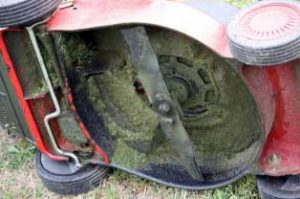The Benefits Of Proper Winter Storage For Your Petrol Lawn Mower

You've done your last lawn cut for the year so you can pop your mower back in the shed and forget about it until next year... or can you?
Remember how hard it was to get it going again? Did you just go out and buy a new one because 'it didn't work any more'?
A few simple steps and an hour of your time to prepare your mower for winter storage will not only save you time and hassle come the spring but could also save you money.
READ THE MANUAL
Firstly make sure you have your mower manual to hand for reference when you work on your mower.
FIRST STEP
If you have a petrol mower, the first job is to drain the tank of fuel.
Depending on which model of mower you have, this would be a good time to refer to the manual and follow the manufacturer's safe guidelines on fuel removal and disposal.
Once the tank has been drained, it's always a good idea to run the mower until it cuts out to clear any fuel that remains in the fuel lines and carburettor.
Fuel that is left in mowers and other garden machinery for long periods of time will separate and cause the other chemicals in the fuel to degrade.

The alcohol in the fuel can dissolve plastic and rubber parts and can attract moisture that will lead to corrosion of metal parts.
Fuel that has degraded will also cause a significant drop in performance and is probably the main reason you struggle to get the mower going in the springtime.
If your mower has a battery then remove it. Give it a wipe over with a cloth and clean the terminals with a soft wire brush if required. There are specialist terminal cleaning and protectant products on the market if needed.
Next, store the battery in a cool, dry area away from any points of ignition.
ELBOW GREASE
It makes sense to give the mower a clean before storing it away.
Firstly, remove the HT lead from the top of the spark plug and brush off the grass, leaves and mud from the mower.
Check the fins on the engine are clear of debris and gently tip the mower and clear the underside.
It's advisable to use a tool such as a screwdriver when cleaning around the blade rather than your hands.
Inspect the cutting blade for damage and replace or re-sharpen if required.

It's a good idea to lubricate and brush a thin coat of oil on to the blade before storage to protect from possible corrosion.
ENGINE WORK
Don't be put off by this; modern engines are much simpler to work on and you don't need much mechanical knowledge to service your mower's engine.
Your mower may have even come with the tools you'd need to carry the following out:
SPARK PLUG
Remove and inspect the spark plug. If there are any visible signs of damage then it's best to replace the spark plug.
If the spark plug is fine then gently clean the base of the plug with a soft wire brush and check that the plug gap is as per the manufacturer's specification by referring to the manual.
OIL CHANGE
Winter storage is a good time to change the oil and oil filter (if fitted). Refer to the manual for the manufacturer's recommended way of draining and disposing of the oil and replace with the correct amount of specified oil.
Oil will become less efficient over time due to the breakdown of molecules, so the fresh oil will help lubricate the engine's internal parts, giving you a longer lifespan from your engine.
AIR FILTER
It's also advisable to remove and clean or replace the air filter.
The air filter provides air, free from dust or dirt particles to help the engine run, so giving it a good clean or replacing it helps the engine to run cleanly and smoothly.
Refer to the manual on how to remove the filter and depending on the type of filter installed it may be as simple as tapping the dust from the filter element to washing in warm soapy water.
LUBRICATE
For winter storage, it can help to remove the spark plug and pour a small amount (teaspoon) of oil into the cylinder bore and pull the recoil handle several times. This will coat the cylinder wall with a layer of oil that will lubricate and prevent seizing and protect from corrosion.
Once you've done this, replace the spark plug.
It's also worth lubricating all pivot points and cable movement points with a good quality spray grease - this will help everything work as it should come spring.
FINALLY
Find a cool, dry, level place to store the mower.
Try to keep it away from other chemicals or furnaces, boilers, etc, and even consider covering with a tarpaulin.
Come next spring, these simple-to-perform tasks will greatly help in starting your mower and prolonging its life.

